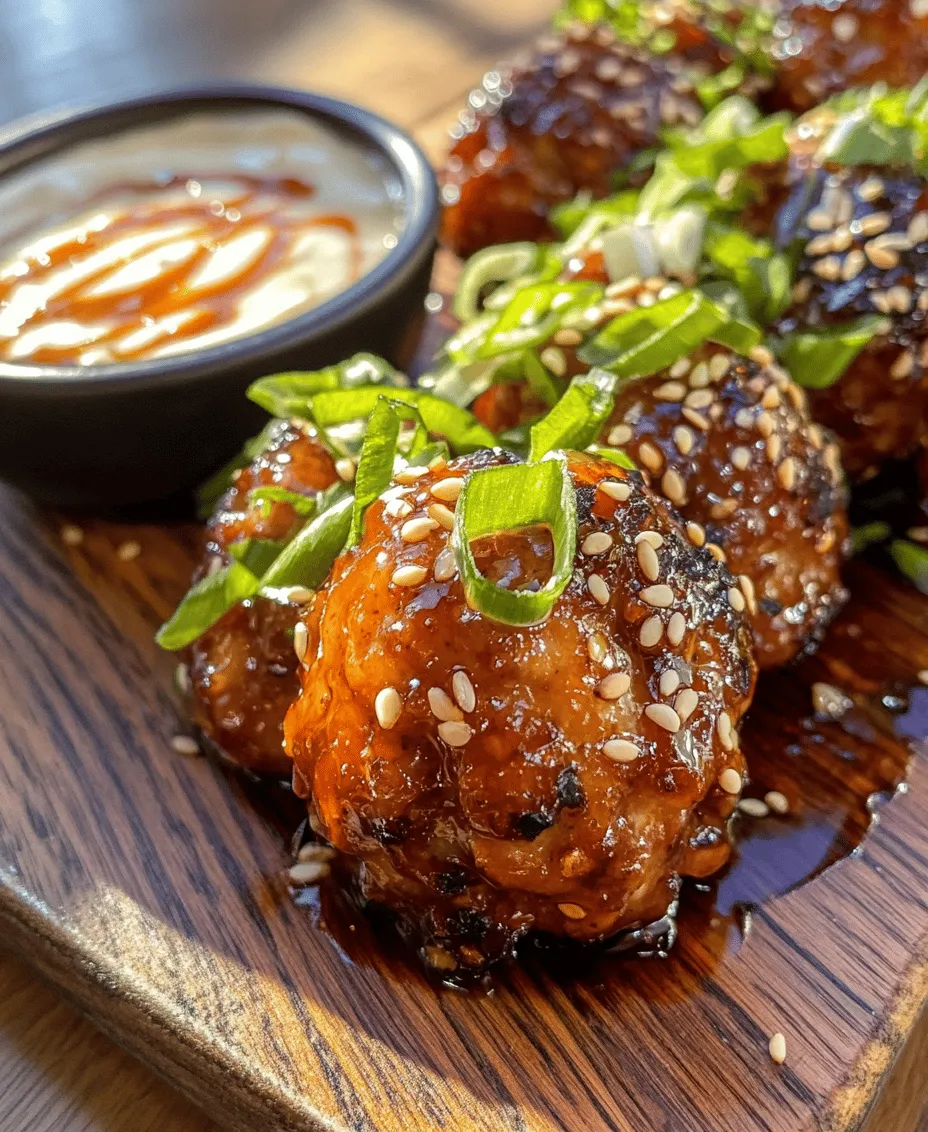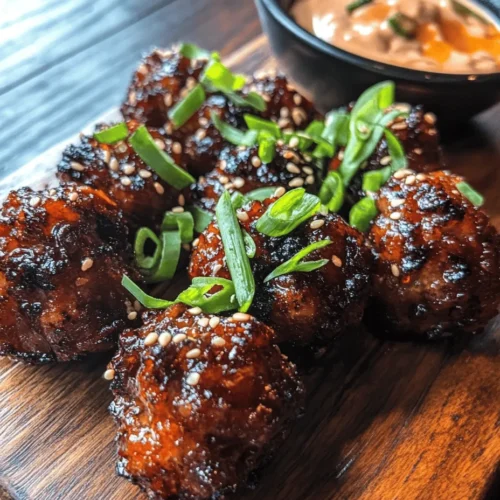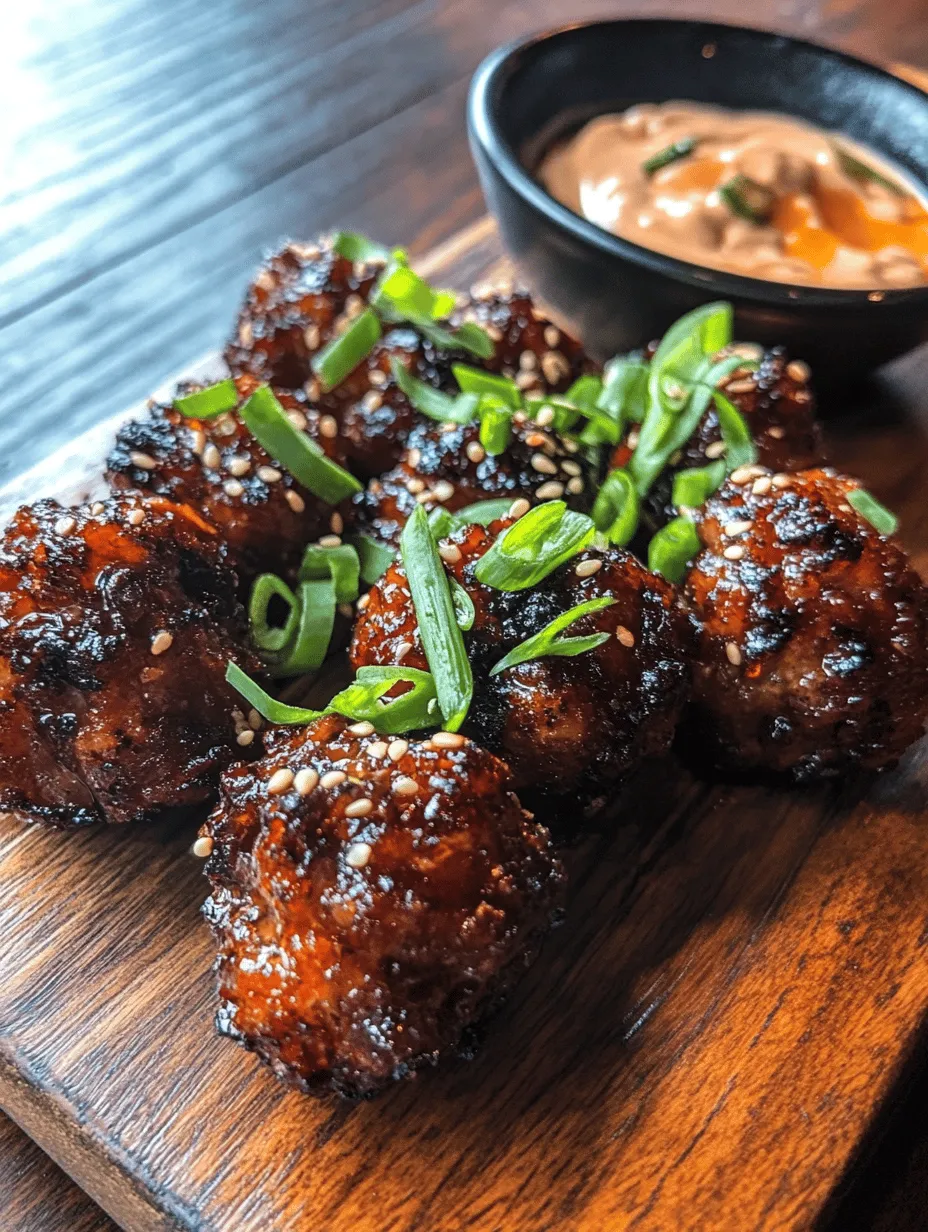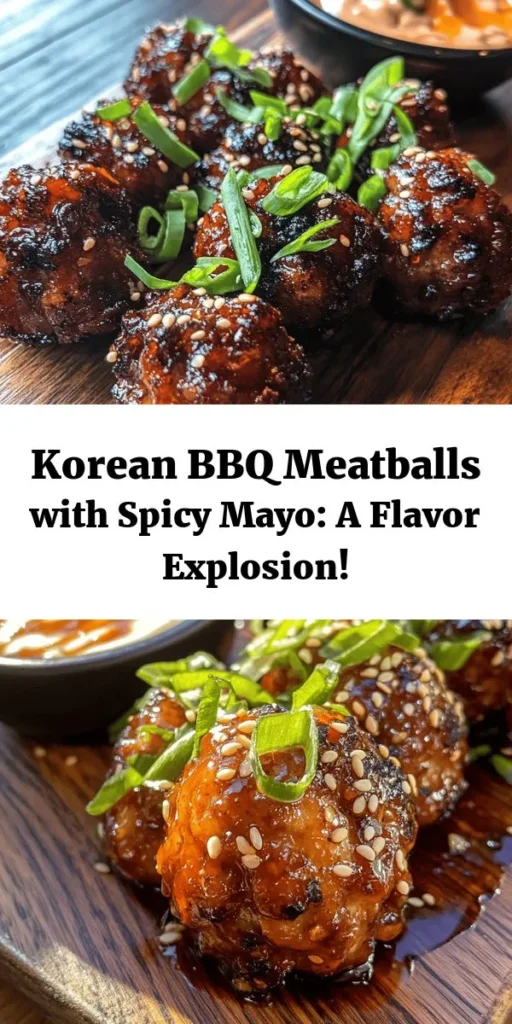Introduction
Korean BBQ Meatballs with Spicy Mayo Dip is a delightful fusion dish that brings the rich flavors of Korean cuisine into a fun and approachable format. These tender meatballs, infused with aromatic ingredients like garlic, ginger, and gochujang, are complemented perfectly by a creamy, spicy mayo dip. Whether you’re hosting a gathering or simply looking for a tasty snack, this recipe has something for everyone. The combination of savory meatballs and a zesty dip not only makes for an irresistible appetizer but also serves as a satisfying main dish for any occasion. In this article, we will explore the ingredients, preparation steps, and unique flavors that make this dish a must-try.
Understanding Korean Cuisine
The Influence of Korean BBQ
Korean BBQ, known locally as “gogi-gui,” which translates to “meat roast,” is more than just a meal; it is a cultural experience that emphasizes communal dining. Diners gather around a grill, cooking their own meat and vegetables while enjoying various side dishes, known as “banchan.” This interactive style of dining fosters a sense of togetherness and celebration, making it a popular choice for gatherings and special occasions.
Korean BBQ typically features marinated meats, such as bulgogi (marinated beef) and galbi (marinated short ribs), which are grilled to perfection over charcoal or gas. The marinades often include a blend of soy sauce, sesame oil, garlic, and sugar, which impart a delicious umami flavor. These elements of Korean BBQ not only enhance the taste of the meat but also reflect the country’s culinary heritage, where bold flavors and fresh ingredients reign supreme.
Popular Ingredients Used in Korean Cooking
Korean cuisine is characterized by its vibrant ingredients. Staples include rice, vegetables, and a variety of meats, complemented by an array of seasonings. Some key ingredients that define Korean dishes are:
– Gochujang: A fermented red chili paste that adds depth and heat to dishes.
– Miso: A fermented soybean paste used in soups and marinades.
– Sesame Oil: Adds a nutty flavor and aroma to various dishes.
– Garlic and Ginger: Essential aromatics that enhance the overall flavor profile.
These ingredients come together to create a harmonious balance of sweet, salty, and spicy flavors that define Korean cuisine.
Significance of Gochujang in Korean Dishes
Among the many ingredients that play a crucial role in Korean cooking, gochujang stands out as a staple. This versatile chili paste is made from fermented soybeans, glutinous rice, red chili powder, and salt. It plays a significant role in enhancing the flavor of dishes, providing a unique combination of sweetness and spiciness.
Gochujang is not only a flavor enhancer but also boasts health benefits. It is rich in antioxidants and has been linked to weight loss and improved metabolism. For those who prefer milder flavors, adjusting the amount of gochujang in recipes allows for a customizable spice level.
The Benefits of Homemade Meatballs
Why Choose Homemade?
Making homemade meatballs offers numerous advantages over store-bought options. When you prepare them from scratch, you have complete control over the ingredients and flavors, allowing you to create a dish that reflects your personal taste preferences. This level of control also enables you to source high-quality ingredients, ensuring that your meatballs are both delicious and nutritious.
Healthier Alternatives to Store-Bought Options
Store-bought meatballs often contain fillers and preservatives that can compromise their flavor and quality. By making your own, you can opt for leaner cuts of meat, ensuring a healthier meal. Additionally, homemade meatballs can be tailored to accommodate various dietary restrictions, whether you need gluten-free options or wish to substitute certain ingredients for health reasons.
Customization Possibilities for Dietary Preferences
One of the most appealing aspects of homemade meatballs is the opportunity to customize them to suit your dietary needs. Whether you prefer beef, pork, or even plant-based alternatives, you can adapt the recipe accordingly. Furthermore, you can experiment with various herbs, spices, and sauces to create a unique flavor profile that resonates with your taste buds.
Ingredients Breakdown for Korean BBQ Meatballs
Meat Choices: Beef vs. Pork
When making Korean BBQ meatballs, you have the option of using either beef or pork. Each choice has its unique flavor profile and texture, which can significantly impact the final dish.
Nutritional Comparison
– Beef: Rich in iron and protein, beef is a popular choice for its robust flavor. Ground beef typically contains higher fat content, which contributes to juiciness but can also lead to a heavier dish.
– Pork: Ground pork is often considered sweeter and more tender than beef. It is slightly lower in protein but offers a unique taste that complements the spices used in Korean cuisine.
Flavor Profiles and Texture Differences
The decision between beef and pork can ultimately depend on your taste preference. Beef tends to have a stronger flavor, while pork provides a milder, sweeter profile. The texture of the meatballs will also vary accordingly, with beef creating a denser meatball and pork resulting in a softer, more tender bite.
Essential Ingredients for Flavor
Beyond the choice of meat, several essential ingredients contribute to the overall flavor of Korean BBQ meatballs.
Role of Breadcrumbs in Meatballs
Breadcrumbs act as a binding agent, helping to hold the meatballs together while providing a tender texture. They absorb moisture, ensuring that the meatballs remain juicy while cooking. You can use traditional breadcrumbs, panko for added crunch, or even gluten-free alternatives, depending on your dietary needs.
Importance of Green Onions, Garlic, and Ginger
Green onions, garlic, and ginger are aromatic staples in Korean cuisine that elevate the flavor of meatballs. Green onions add a fresh, slightly sharp taste, while garlic and ginger impart warmth and depth. The blend of these aromatics creates a well-rounded flavor profile that is quintessential to Korean cooking.
Exploring the Flavors of Soy Sauce and Sesame Oil
Soy sauce is another key ingredient that enhances the umami flavor in meatballs, while sesame oil provides a nutty aroma that ties the dish together. Both ingredients play a pivotal role in marinating the meat and adding complexity to the overall taste.
Gochujang: The Star of the Dish
Understanding Korean Chili Paste
Gochujang is the star ingredient in Korean BBQ meatballs, adding a distinct flavor and spice level that elevates the dish. This fermented chili paste is characterized by its deep red color and thick consistency, making it an essential component in many Korean recipes.
Health Benefits and Flavor Contribution
In addition to its flavor profile, gochujang is known for its health benefits. It contains vitamins and minerals, along with probiotics due to the fermentation process, which can promote gut health. The paste’s natural sweetness, combined with its heat, enhances the overall complexity of the meatballs, making them incredibly satisfying.
Tips for Adjusting Spice Levels
For those who prefer milder flavors, it is easy to adjust the amount of gochujang in the recipe. Start with a smaller quantity, taste the mixture, and gradually increase the amount until you achieve your desired spice level. This allows you to enjoy the rich flavors of Korean cuisine without overwhelming your palate.
Creating the Perfect Meatball Mixture
Step-by-Step Preparation
Creating the perfect meatball mixture is crucial for achieving the right texture and flavor. Follow these steps to ensure your meatballs turn out tender and delicious.
1. Combine Ingredients: Start by placing your chosen ground meat in a large mixing bowl. Add in the breadcrumbs, minced garlic, grated ginger, chopped green onions, soy sauce, sesame oil, and gochujang.
2. Mix Gently: Use your hands to mix the ingredients together. It is essential to combine them without overworking the meat, as this can lead to tough meatballs. Aim for a consistent mixture where all ingredients are evenly distributed.
3. Add Moisture: If the mixture feels too dry, consider adding a splash of water or an egg to enhance moisture and binding. These additions can help achieve the desired consistency.
4. Season to Taste: Before shaping the meatballs, taste a small amount of the mixture (cooked in a pan) to check for seasoning. Adjust with more soy sauce or gochujang as needed.
Tips for Achieving the Right Consistency
The ideal meatball mixture should be moist but firm enough to hold its shape. Here are some tips to ensure perfect consistency:
– Avoid Overmixing: Mix until just combined to prevent tough meatballs.
– Chill the Mixture: If time allows, refrigerate the meatball mixture for about 30 minutes. Chilling helps the flavors meld and makes it easier to shape.
With these steps, you are well on your way to creating delicious Korean BBQ meatballs that will impress your guests and satisfy your cravings. As we move forward, we will explore the shaping and cooking process that brings these flavorful morsels to life. Stay tuned for more details on how to perfectly shape and cook your meatballs for a delightful dining experience.

Forming Techniques
Creating uniform meatballs is essential for even cooking and presentation. Here are some best practices:
– Use a Scale: For consistent size, weighing your meatballs can be beneficial. Aim for each meatball to be around 1-1.5 ounces. This ensures they cook at the same rate, preventing some from being overdone while others remain raw.
– Wet Hands: When forming the meatballs, wet your hands with water or oil to prevent the meat from sticking. This technique makes it easier to shape each ball without the mixture clumping to your fingers.
– Gentle Handling: Avoid overworking the meat mixture as this can lead to tough meatballs. Mix the ingredients just until combined and then form them gently into balls.
– Uniform Pressure: Roll the meatballs in your palms using consistent pressure to create a smooth surface. This not only enhances their appearance but also helps them cook evenly.
Why Size Matters in Cooking
The size of your meatballs can significantly impact the cooking time and final texture. Smaller meatballs (around 1 inch) will cook quickly and might be slightly crispy on the outside while remaining juicy inside. Larger meatballs (1.5 inches or more) may take longer to cook through, but they can offer a heartier bite.
Baking vs. Frying
When it comes to cooking your Korean BBQ meatballs, both baking and frying have their merits.
Pros and Cons of Baking Meatballs
– Pros:
– Healthier Option: Baking allows fat to drip away, resulting in a lower-calorie dish compared to frying.
– Hands-Free Cooking: Once in the oven, you can focus on other tasks without needing to watch or flip the meatballs constantly.
– Even Cooking: The steady heat of the oven cooks the meatballs evenly, providing a uniform texture.
– Cons:
– Less Crispiness: While baking can result in a pleasing texture, it may not achieve the same level of crispiness as frying.
– Longer Cooking Time: Baking may take longer than frying, so plan accordingly if you’re short on time.
How Baking Retains Flavor and Texture
Baking meatballs at a moderate temperature (around 400°F) allows the flavors to develop without losing moisture. The Maillard reaction, which occurs during baking, enhances the overall flavor profile, giving your meatballs that delightful caramelization without the need for excessive oil.
Crafting the Spicy Mayo Dip
A perfect accompaniment to your Korean BBQ meatballs is a spicy mayo dip that balances creaminess with heat.
Ingredients and Flavor Balance
The basic components of the spicy mayo dip include:
– Mayonnaise: This serves as the base, providing creaminess.
– Sriracha or Gochujang: For heat and a touch of sweetness, choose Sriracha for a vinegary kick or Gochujang for a richer, fermented flavor.
– Lime Juice: Adds acidity to balance the richness of the mayonnaise.
– Sesame Oil: Provides a nutty undertone and enhances the overall flavor profile.
Adjust the spice and sweetness levels by experimenting with the ratios. For a milder dip, decrease the amount of hot sauce, or add a splash of honey to increase sweetness.
Whisking It Together
To achieve the perfect dip consistency:
1. Combine Ingredients: In a medium bowl, add mayonnaise, Sriracha or Gochujang, lime juice, and sesame oil.
2. Whisk Vigorously: Use a whisk to mix until the ingredients are fully integrated and the texture is smooth.
3. Let It Rest: Allow the dip to sit for at least 30 minutes before serving. This resting period helps the flavors meld, resulting in a more cohesive taste.
Serving Suggestions for Korean BBQ Meatballs
Presentation can elevate the dining experience of your Korean BBQ meatballs.
Presentation Ideas
– Garnishing with Sesame Seeds: Sprinkle toasted sesame seeds over the meatballs prior to serving for added texture and a visual appeal.
– Complementary Sides: Serve the meatballs alongside steamed rice and kimchi. The rice absorbs the flavors of the meatballs, while the kimchi adds a refreshing crunch and acidity.
Pairing Recommendations
– Best Beverages: To complement the rich flavors of the meatballs, consider pairing with light beers, such as a Korean lager, or a crisp white wine like Riesling. For a non-alcoholic option, try a refreshing iced tea or sparkling water with lemon.
– Suggestions for Additional Appetizers: If you’re hosting a gathering, consider offering a selection of Korean-inspired appetizers such as mandu (Korean dumplings) or a simple vegetable platter with dipping sauces.
Nutritional Information
Understanding the nutritional profile of your Korean BBQ meatballs can help you make informed choices.
Caloric Breakdown
Each serving of Korean BBQ meatballs (approximately four meatballs) contains around 300-400 calories, depending on the specific ingredients used. The dip adds approximately another 100-150 calories, so be mindful of portion sizes if you’re watching your intake.
Key Nutrients Found in the Dish
These meatballs are a source of:
– Protein: Lean ground meat provides essential amino acids.
– Vitamins: Depending on the vegetables used in the mixture or as sides, you’ll gain vitamins A, C, and K.
– Healthy Fats: Sesame oil in the dip contributes healthy fats, supporting heart health.
Health Considerations
For those with dietary restrictions or specific health goals, consider the following adjustments:
– Gluten-Free: Use gluten-free breadcrumbs or omit them altogether, using almond flour as a binder instead.
– Low-Carb: Substitute traditional breadcrumbs with ground flaxseed or cauliflower rice to reduce carbs while maintaining texture.
– Incorporating Lean Proteins: Opt for lean ground turkey or chicken to reduce fat content while still enjoying the dish’s flavor.
Conclusion
Korean BBQ Meatballs with Spicy Mayo Dip is not just a recipe; it’s an experience filled with flavor and cultural significance. By combining high-quality ingredients and traditional Korean flavors, this dish offers a delicious option for any occasion. Whether enjoyed as a snack or a main course, these meatballs are sure to impress and satisfy your taste buds. With easy preparation and minimal cooking time, they are a perfect choice for any home cook looking to bring a taste of Korea to their table.
The delightful combination of juicy meatballs and creamy, spicy dip offers a perfect balance of textures and flavors. Dive into this culinary adventure and treat yourself and your loved ones to a meal that is both comforting and invigorating, showcasing the best of Korean cuisine.



